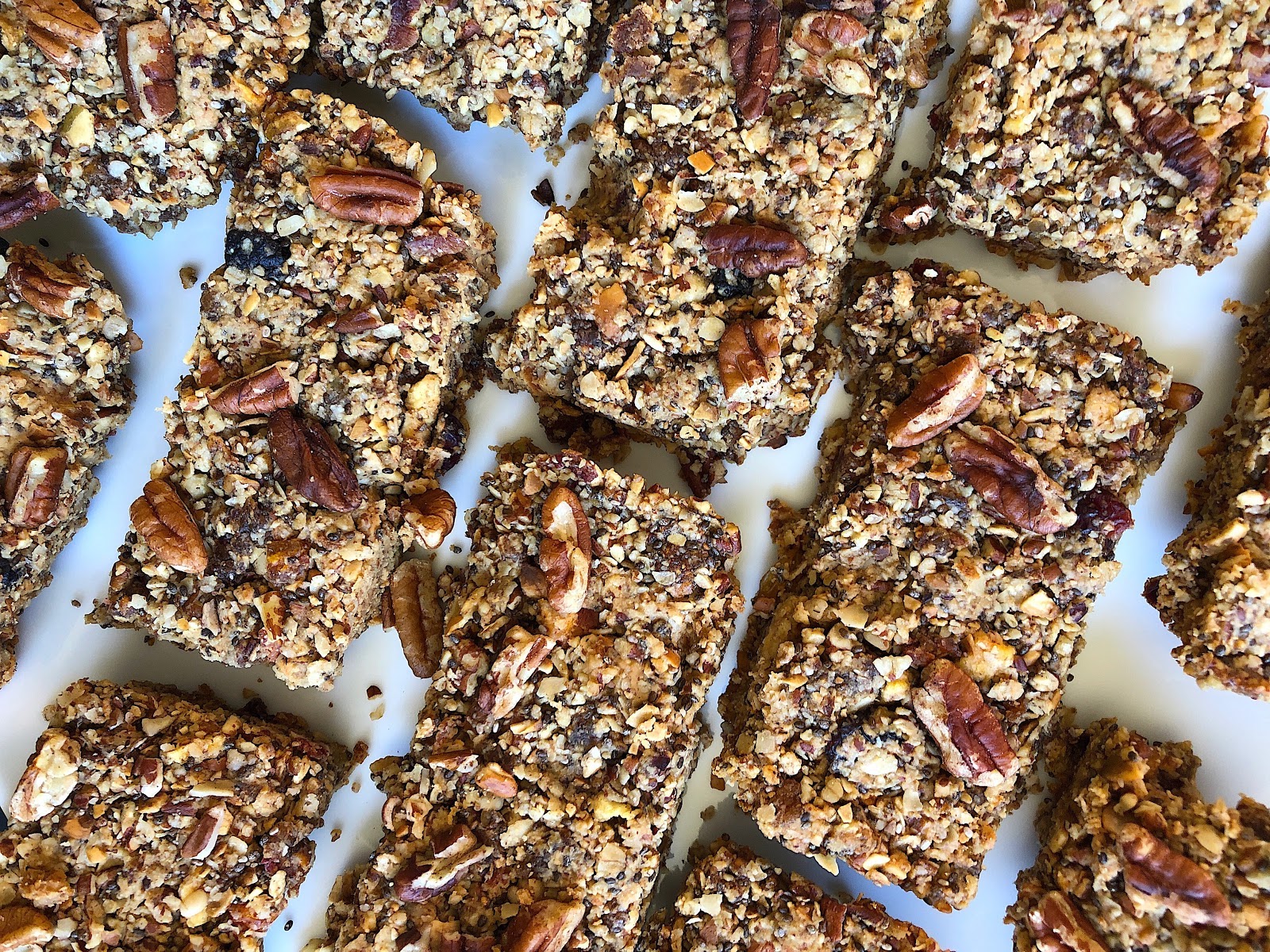Many calcium-rich foods are dairy products – a food group many of us struggle to digest. In addition to this factor, there are several nutrients that also must be plentiful in the body in order for calcium to be properly absorbed, stored, and used efficiently as a cell signal. With this in mind, Laura Lewis of Metabolic Maintenance formulated this healthy granola bar recipe to be loaded with calcium-rich, dairy-free ingredients for supporting musculoskeletal health.
This recipe has also been designed to deliver complementary nutrients so that calcium can be put to its best use. Make it on a Sunday so you have nutritious snacks on hand throughout the school and work week to nourish your family’s bones, bodies, and brains.

Chia seeds
Chia seeds can deliver a significant dose of calcium. The daily recommended calcium intake for adults is about 1000 mg and each tablespoon of chia seeds contains at least 10% of that amount [1,2]. They are also a terrific source of protein, fiber, and α-linolenic acid [2,3]. An animal study published in 2018 noted a strong correlation between long-term intake of chia seeds and bone mineral density (among other benefits), suggesting that regular consumption of chia seeds may promote musculoskeletal health [3]. This effect may not be strictly in response to calcium, however. A 2017 review of micronutrients, showed that n-3 fatty acids (such as α-linolenic acid) are likely to promote healthier bone, skeletal muscle, and cognitive function, especially in older adults [4].
Chia seeds also contain boron, which is an essential mineral for growth and maintenance of bone, absorption of magnesium, and activation of SAMe (which plays a role in joint comfort) [5].
Pumpkin seeds
While pumpkin seeds do contain some calcium, they are an excellent source of vitamin K and possibly the best source of dietary magnesium [6,7]. The USDA estimates up to 79% of all American adults do not consume the recommended amount of magnesium daily, and this proportion is likely greater in adolescents and men over 71 [7,8]. Magnesium is imperative to good health as it participates in at least 600 enzymatic reactions in the body [9]. Its contributions to the musculoskeletal system include contraction and relaxation of muscles, new protein formation, and cellular energy production [10]. When serum magnesium is too low, the mineral will be pulled from storage in bones, thereby weakening bone structure. However, just 1 oz of pumpkin seeds contains about half of the daily magnesium requirement for women and over one-third of the requirement for adult men [6,7].
Pecans and Almonds
Nuts are another good source of calcium and magnesium, but also contain omega-3 fatty acids and vitamin E –two powerful anti-inflammatory nutrients. Natural anti-inflammatories such as these can help with the uncomfortable symptoms of arthritis or pain and swelling in joints. Studies have shown that rheumatoid arthritis patients consuming a moderate amount of omega-3 polyunsaturated fatty acids daily (>2.7 g), relied less on non-steroidal anti-inflammatory drugs (NSAIDs) that those with less or no omega-3s in their diet [11].
Vitamin E (α-tocopherol) is the major antioxidant found in biological membranes and is an important component of normal synovial fluid in joints. Evidence suggests that vitamin E is consumed by inflamed joints as it is used for its antioxidant activities, and so low levels of vitamin E may have a detrimental effect on inflammatory arthritis [12].
Figs
Dried figs are rich in antioxidants and fiber, and contain more calcium than other dried fruits. In fact, dried figs provide 5% of the RDI for calcium in one ounce (28 grams) [13].
Moreover, figs provide potassium and vitamin K. Eighty percent of the potassium in your body is found in skeletal muscle, where it regulates cellular hydration and conducts electricity, allowing muscles to contract [14]. Another significant portion is found in bone where it contributes to bone mass and strength, helping to prevent osteoporosis [15].
Low vitamin K is also related to osteoporosis, as it is needed to support the action of vitamin D in the process of bone mineralization [16].
Ingredients
1 cup raw almonds
1 cup raw pecans
½ cup raw pumpkin seeds
¼ cup chia seeds
1½ cups oats
¼ cup extra-virgin olive oil
6 large dried figs
6 dates
½ cup dried cranberries (or raisins)
1 cup peanut butter
½ cup honey (substitute with ⅓ cup agave for truly vegan recipe)
1 tsp sea salt
2 tbsp. vanilla extract
Instructions
- Preheat oven to 350°F. Spread almonds, pecans, and pumpkin seeds out on a baking pan and roast 10–12 minutes. Pumpkins seeds will turn from green to gold, and almonds and pecans should darken without burning. Allow the nuts to cool for a few minutes. Reserve a handful of whole nuts to garnish tops of bars.
- Turn the oven down to 300°F.
- Into a food processor, add 1 cup oats, roasted nuts and seeds, and chia seeds. Pulse to chop until nuts are uniformly small and no whole oats are visible. Transfer to a large bowl. Then use a food processor to chop dried figs, dates, and cranberries. Similarly, pulse to chop until fruit chunks are uniformly small and no whole cranberries are visible. Transfer to the bowl with the oat, nut, and seed mixture. Stir in ½ cup whole oats and 3 tablespoons of olive oil, distributing evenly.
- In a medium saucepan, add honey, salt, and vanilla and bring to a boil over medium heat. Reduce heat to a simmer, and let the honey bubble for 2 minutes, stirring occasionally. Turn off heat and stir in peanut butter. Keep stirring until peanut butter is melted and then drizzle over the bowl of granola. Fold and stir until completely incorporated.
- Transfer granola mixture into a 9 x 13” pan lined with parchment paper. Spread the mixture out and press it firmly into an even layer using another glass-bottom pan or a flat-bottom measuring cup for pressure.
- Bake the pan of granola for 30-35 minutes, or until it starts to turn golden around the edge. Remove pan from the oven and cut into bars while the pan is still hot. Let bars cool completely in the pan, then move parchment to a cutting board and break bars apart using a sharp knife.
Granola bars can be served immediately or stored in an airtight container for up to a week.
- NIH. “Calcium and Vitamin D: Important and Every Age.” NIH Osteoporosis and Related Bone Diseases National Resource Center. Accessed October 19, 2020. https://www.bones.nih.gov/health-info/bone/bone-health/nutrition/calcium-and-vitamin-d-important-every-age#b
- USDA. “CHIA.” USDA Agricultural Research Service. FoodData Central. Accessed October 19, 2020. https://ndb.nal.usda.gov/fdc-app.html#/food-details/984343/nutrients
- Cunnane, Stephen C., et al. “High α-linolenic acid flaxseed (Linum usitatissimum): some nutritional properties in humans.” British Journal of Nutrition 69.2 (1993): 443-453.
- Iolascon, Giovanni, et al. “Are dietary supplements and nutraceuticals effective for musculoskeletal health and cognitive function? A scoping review.” The journal of nutrition, health & aging 21.5 (2017): 527-538.
- Pizzorno, Lara. “Nothing boring about boron.” Integrative Medicine: A Clinician’s Journal 14.4 (2015): 35.
- USDA. “Pumpkin seeds, unslated.” USDA Agricultural Research Service. FoodData Central. Accessed October 19, 2020. https://ndb.nal.usda.gov/fdc-app.html#/food-details/784459/nutrients
- NIH. “Magnesium.” NIH Office of Dietary Supplements: Fact Sheet for Health Professionals. Accessed October 19, 2020. https://ods.od.nih.gov/factsheets/Magnesium-HealthProfessional/
- Moshfegh, Alanna, et al. “What we eat in America, NHANES 2005–2006: usual nutrient intakes from food and water compared to 1997 dietary reference intakes for vitamin D, calcium, phosphorus, and magnesium.” US Department of Agriculture, Agricultural Research Service (2009).
- De Baaij, Jeroen HF, Joost GJ Hoenderop, and René JM Bindels. “Magnesium in man: implications for health and disease.” Physiological reviews (2015).
- Rude, Robert K., Frederick R. Singer, and Helen E. Gruber. “Skeletal and hormonal effects of magnesium deficiency.” Journal of the American College of Nutrition 28.2 (2009): 131-141.
- Lee, Young-Ho, Sang-Cheol Bae, and Gwan-Gyu Song. “Omega-3 polyunsaturated fatty acids and the treatment of rheumatoid arthritis: a meta-analysis.” Archives of medical research 43.5 (2012): 356-362.
- Karlson, Elizabeth W., et al. “Vitamin E in the primary prevention of rheumatoid arthritis: the Women’s Health Study.” Arthritis Care & Research 59.11 (2008): 1589-1595.
- USDA. “Figs, dried, uncooked.” USDA Agricultural Research Service. FoodData Central. Accessed October 19, 2020. https://ndb.nal.usda.gov/fdc-app.html#/food-details/786606/nutrients
- Cheng, Chih-Jen, Elizabeth Kuo, and Chou-Long Huang. “Extracellular potassium homeostasis: insights from hypokalemic periodic paralysis.” Seminars in nephrology. Vol. 33. No. 3. WB Saunders, 2013.
- New, Susan A., et al. “Dietary influences on bone mass and bone metabolism: further evidence of a positive link between fruit and vegetable consumption and bone health?.” The American journal of clinical nutrition 71.1 (2000): 142-151.
- Fusaro, Maria, et al. “Vitamin K and bone.” Clinical Cases in Mineral and Bone Metabolism 14.2 (2017): 200.
Share:
Related Posts

Goodbye Pie Chart, Hello Phase 1 Sliders
Written by Allison Smith, ND | 2025 As we usher in a new era of DUTCH testing which leaves behind the concept of the three-way

Introducing the DUTCH Dozen
Written by Kelly Ruef, ND | 2025 Hormone testing can be complex, which is why Precision Analytical developed the DUTCH Dozen, an interpretive framework that

DUTCH Report Enhancements
Written by Hilary Miller, ND | 2025 Precision Analytical have released the newest version of the DUTCH Test. This is the report’s most significant update

Gallbladder Health 101: What It Does and How to Keep It Working Well
Written by Ashley Palmer & Pooja Mahtani | 2025 The gallbladder may not get much attention compared to the gut, but it plays a central

Can You Bring Vitamins on a Plane? How To Travel with Supplements
Written by Austin Ruff | 2024 Are you traveling for a work conference, an athletic competition, or a weekend getaway? Just because you’re leaving home
